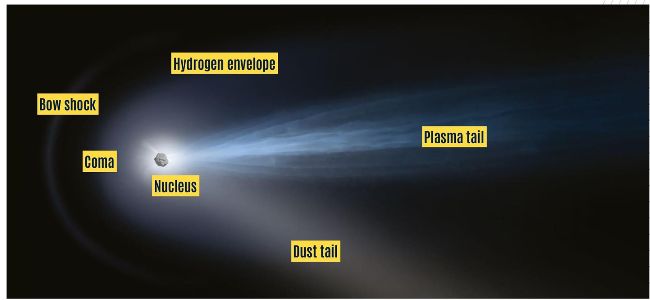ULTIMATE GUIDE TO COMETS
Written by Stuart Atkinson
• WHERE THEY COME FROM • HOW THEY SPARK LIFE
•
THIS YEAR’S UNMISSABLE EVENTS
• MAKE YOUR OWN DISCOVERY
A comet bright enough to be seen with the naked eye is one of the most fascinating and thrilling sights in astronomy, and the appearance of a great comet, with a bright head and glowing tail, is a very rare event indeed. The last great comet to grace our skies was comet Hale-Bopp in 1997. That beautiful twin-tailed comet was seen by millions around the world, but that world was very different to the one we live in today. The internet was still young, and social media had yet to be born. There were no computerised telescopes, no astronomy phone apps, no fancy CCD cameras or stacking of images.In many ways Hale-Bopp was the last great comet of the pre-digital age. Next autumn, Comet C/2023 A3 Tsuchinshan-ATLAS might be the brightest comet in the sky since Comet Hale-Bopp. If it lives up to expectations, we might see the return of old-fashioned ‘comet fever’ as reports of the comet’s appearance and thousands of breathtaking digital images of it flood social media. If it falls short, astronomers might face a level of disappointment and anger not seen since Comet ISON – predicted to be the comet of the century – sputtered out and fell to pieces back in 2013. So now is a good time to take a deep breath and take a look at comets – what we used to think about them, what we know about them now and how to observe them – and take an early look at what we might see in the sky at the end of next year.
WHAT ARE COMETS?
We once believed that comets were strange, vaporous objects that trailed through Earth’s atmosphere, or flaming rocks from the depths of space that passed by our planet. Today, after centuries of observation and research, we know that comets are among the most ancient bodies in our Solar System. We know they are icy bodies that contain large amounts of dust and gas. They are members of the Solar System, just like the planets, but while the orbits of the planets are roughly circular, comets’ orbits are much more eccentric, so they spend most of their time far away from the Sun and only come near it for a small part of their orbit. Some comets take only a few years to go around the Sun, while others take hundreds, thousands or even tens of thousands to orbit it.
The solid part of a comet is called the nucleus. It is a very dark, icy body, almost like a huge charcoal briquette tumbling through space. Comets only show themselves when they get close enough to the Sun for its heat to thaw them out enough to release some of the dust and gas from the nucleus. This forms a glowing cloud, or ‘coma’, around the nucleus, which reflects sunlight, making the comet visible. Some comets never go further than this, but some go on to grow long, beautiful tails, which can make them lovely objects in the night sky. Comets usually grow two types of tail: a dust tail, which is yellowish in colour and traces out the path of the comet around the Sun, and a gas tail, which is blown away from the nucleus by the solar wind. Comet tails can stretch for many millions of kilometres away from the comet. The tail of Comet Ikeya-Zhang was measured at more than seven times the distance between the Sun and Earth. Comet tails can change in appearance over time as they break up into different strands and braids and material flows down them, forming knots and clumps of dust and gas.
“Comets are among the most ancient bodies in our Solar System – icy bodies that contain large amounts of dust and gas”

©Getty
COMETS IN HISTORY
Comets have been observed for thousands of years. Records show that ancient Chinese skywatchers documented the first detailed observations of comets around 613 BCE, although some believe they recorded the appearance of Halley’s Comet even earlier, in 1059 BCE. In 372 CE, on the other side of the world, Greek philosopher Aristotle was entranced by his view of a magnificent comet. This great comet had a bright-red tail that crossed a third of the sky. It was so bright that it reportedly cast shadows on the ground like the Moon.
There have been many spectacular comets throughout history. In 1577, Danish astronomer Tycho Brahe observed a great comet blazing in the sky above Europe, and the detailed measurements he made of its track across the sky led to him to propose that comets were much further away than the Moon, and weren’t just strange atmospheric phenomena. 1843 was the year of the Great March Comet, one of a class of comets now referred to as ‘sungrazers’ because they pass very close to the Sun as they whip around it, sometimes even skimming through its outer atmosphere. It developed an extremely long tail that was more than twice as long as the distance between Earth and the Sun.